#datemaki
Text
料理トリビアのまとめ #0009
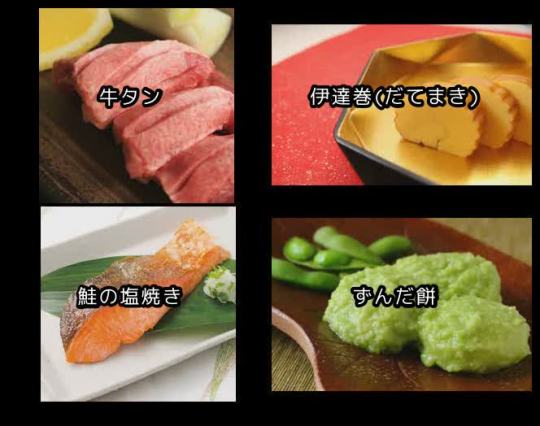
#宮城の郷土料理#Zunda mochi#Miyagi local cuisine#鮭の塩焼き#ずんだ餅#伊達巻#JapaneseCooking#料理トリビア#Ox tongue#Datemaki#Salt-grilled salmon#牛タン
0 notes
Photo

伊達巻(だてまき)
宮城の郷土料理
伊達巻(だてまき)は、宮城県仙台市周辺で親しまれている伝統的な和菓子の一つです。特にお祝い事やお土産として人気があります。
伊達巻は、蒲鉾(かまぼこ)や卵焼きを使って巻いた和菓子で、形状は筒状または巻き巻きの形をしています。主な材料は、魚のすり身を練りこんだ蒲鉾や、卵を焼いて巻いた卵焼き(だし巻き卵)です。これらを糸で巻いて一緒に焼いたり、調理して巻いて作られます。
伊達巻は、見た目が華やかで美しいことから、お祝いの席やお土産として贈られることが��く、結納やお祝い事の際にも喜ばれる和菓子です。伝統的な技術を使って作られることもあり、地元の人々や観光客が楽しむ郷土の味として親しまれています。
伊達巻は、仙台市内の和菓子店や土産物店などで手に入れることができます。その色鮮やかな見た目と、ほんのり甘い味わいが特徴であり、宮城県の魅力的な郷土菓子の一つです。
✄🔪🥄🍽✄🔪🥄🍽✄🔪🥄🍽✄🔪🥄🍽
Datemaki
Miyagi local cuisine
Datemaki is a traditional Japanese sweet that is popular around Sendai City, Miyagi Prefecture. It is especially popular for celebrations and as a souvenir.
Datemaki is a Japanese confectionery made using kamaboko or tamagoyaki, and is either cylindrical or roll-shaped. The main ingredients are kamaboko, which is kneaded with minced fish, and tamagoyaki (dashi-maki tamago), which is rolled fried egg. These are made by wrapping them with thread and baking them together, or by cooking and wrapping them.
Due to its gorgeous and beautiful appearance, Datemaki is often given as a gift at celebrations or as a souvenir. It is sometimes made using traditional techniques and is a popular local flavor enjoyed by locals and tourists alike.
Datemaki can be purchased at Japanese sweets shops and souvenir shops in Sendai City. It is characterized by its brightly colored appearance and slightly sweet taste, making it one of Miyagi Prefecture's most attractive local sweets.
0 notes
Photo

#正月 #NewYear #おせち料理 #御節料理 #おせち #Osechi #かまぼこ #伊達巻 #Kamaboko #Datemaki #栗きんとん #KuriKinton #Sweetchestnutpaste #chestnut #栗 #重箱 #multitieredbox #Jubako #正月 #NewYear #japan #日本 #ivvaDOTinfo #ivva Originally, during the first three days of the New Year, it was taboo to use a hearth and cook meals, except when cooking #zoni. Osechi was made by the close of the previous year, as women did not cook in the New Year. https://www.instagram.com/p/CnCzDk7SxCi/?igshid=NGJjMDIxMWI=
#正月#newyear#おせち料理#御節料理#おせち#osechi#かまぼこ#伊達巻#kamaboko#datemaki#栗きんとん#kurikinton#sweetchestnutpaste#chestnut#栗#重箱#multitieredbox#jubako#japan#日本#ivvadotinfo#ivva#zoni
0 notes
Photo
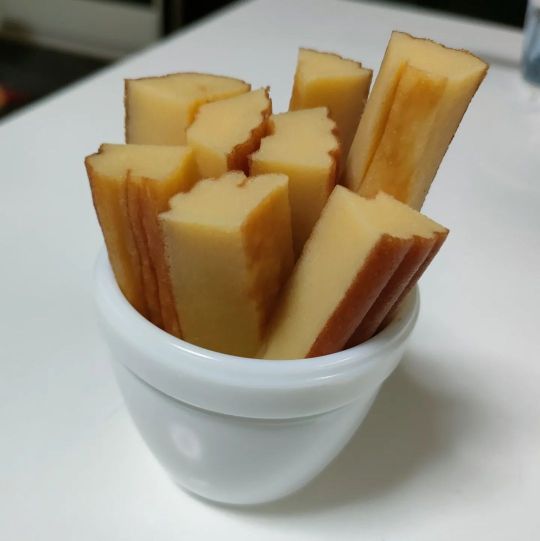
伊達stickと伊達roll #伊達巻 #伊達スティック #伊達巻を縦に切ってみた #伊達stick #伊達roll #伊達ロール #japanesefood #japanesefoods #datemaki #dateroll #japan https://www.instagram.com/p/CnCAHTwplVX/?igshid=NGJjMDIxMWI=
0 notes
Text
Favorite traditional celebration food go. Tag one person (or not) (or also many people idk man).
Japanese 🇯🇵 (dad's side)
Datemaki (Japanese New Year)
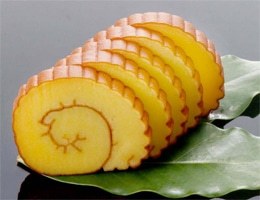
It's like an ever so slightly sweet egg roll and I swear it's the best thing to ever go in my mouth. It's shaped like a scroll and is supposed to represent good luck in school the coming year. My grades are disproportionately bad compared to the amount of datemaki that I eat. It's only a new year food so we can't get it any other time, which is so so sad :(. I love pretty much all Japanese New Year food (it's what I grew up eating, after all) but datemaki takes the cake.
@justtryingtosurviveinthepresent i really wanna see this and if you mention it's basically 2 am for me I will feel called out like you won't believe.
1 note
·
View note
Text

my favorite silly guy…
6 notes
·
View notes
Text
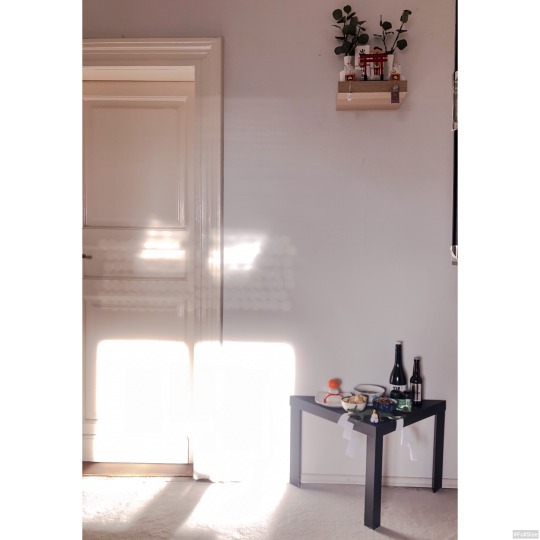




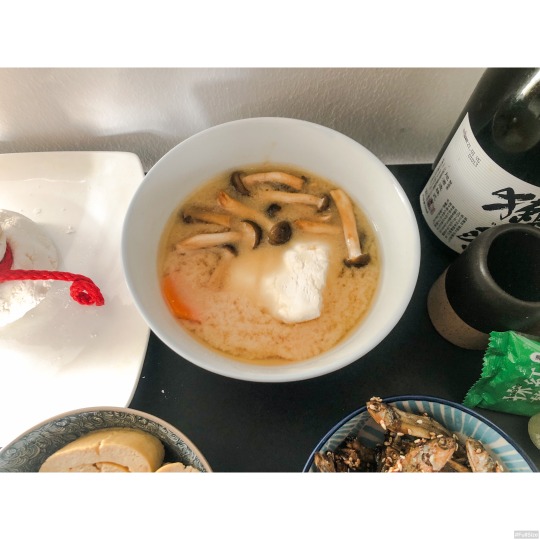
Hát, idén nem vittem túlzásba, sajnos energiám és időm sem volt, hogy ennél autentikusabb újévi ebédet készítsek, a Datemaki kifejezetten csúnya lett (amúgy finom), az újévi dekorációként készült Kagami Mocsi pedig viccesen kicsi lett. A Tuzukuri mondjuk hozza az elvárt szintet, azt nehéz elrontani. Először csináltam viszont Ozonit, ami gyakorlatilag fehér miszoból készült leves mocsival és zöldségekkel, és annyira jó, hogy mostantól egész biztos, szokássá fogom tenni.
2024-től egyébként aránylag sokat várok, elvégre a sárkány éve lesz, én pedig is a sárkány évében születtem (az asztalon látható sárkányt édesapámtól kaptam újszülöttként).
Boldog új évet kívánok nektek és Kami-szama legyen veletek🐉🙏🏻⛩️
7 notes
·
View notes
Photo

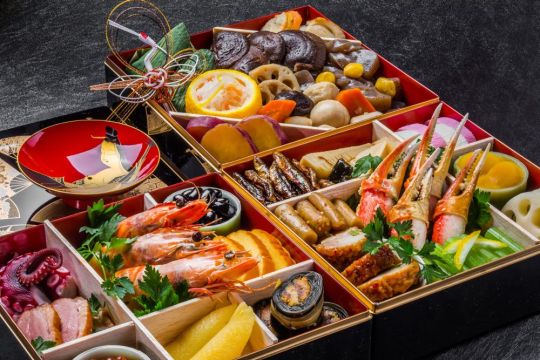
Japanese New Year Tradition: Osechi Ryōri
In Japan, starting off the New Year is more about spending time with family than it is about partying. It's a time of year when people go back to their home towns, pay their first visit to the local shrine, and sit down to some traditional food. And food doesn't get more traditional than osechi ryōri.
The tradition behind osechi ryōri (お節料理) goes back centuries, to the Heian period (794-1185). Ritual offerings of food used to be presented to the gods on sechinichi, or days that marked the changing of the seasons according to traditional Chinese almanacs that were used during this time. The most important sechinichi, of course, was the day that marked the beginning of the New Year. On this day, special dishes were offered to various deities, and also eaten by members of courtly society.
Over the centuries, these traditions made their way to the rest of society, and by the Edo period (1603-1868), they were being practiced commonly around Japan. They combined with other beliefs, notably that on the first days of the New Year, any kind of work — including cooking — was to be avoided. There are two competing theories as to why this was the case. One was that the gods shouldn’t be disturbed by the sounds of cooking on the first days of the year, and the other is simply that the beginning of the year was meant to be a time of rest, when everyone — particularly the women of the household, who did most of the work around the home in those days — could enjoy a well-deserved break.
In the beginning, osechi was quite simple food — vegetables boiled in soy sauce and vinegar — but over the centuries, more and more types of food were added to the osechi ryōri lineup, turning it into a much more elaborate affair. Almost all of these dishes have a special meaning, related either to the name of the food in Japanese or to its appearance or other special characteristics. These are some of the most commonly eaten dishes, and their associated meanings:
Kuromame (黒豆)
Black beans are meant to be a symbol of health, with the associated idea that the person who eats them will be able work hard in the year to come.
Kazunoko (数の子)
This dish is herring roe, but the symbolism is connected both to the large number of tiny eggs, and to the meaning of the Japanese words. Kazu means “number” in Japanese, and “ko” means “children.” The wish behind this item is that the next year will bring many children. For an extra layer of meaning, look to the name of the fish in Japanese: the word for herring is nishin, and if it’s written with an alternate set of kanji (二親), it means “two parents.”
Tazukuri (田作り)
This dish is sardines boiled in soy sauce. Historically, sardines were used to fertilise rice fields, and this word means “rice field maker” in Japanese. Symbolically, this food is eaten in the hopes that the coming year’s harvest will be plentiful.
Kohaku Kamaboko (紅白かまぼこ)
Kamaboko is a kind of fish cake, and kohaku means red and white. The colours represent Japan (most easily found on the country’s flag), and are generally considered to be good luck. According to some, the red colour is meant to prevent evil spirits, while white represents purity. Incidentally, Kohaku Uta Gassen is one of the most popular TV shows that Japanese people watch on New Year’s Eve, and it’s a singing competition between two teams comprising of the most popular singers in Japan — the white (male singers) and the red (female singers).
Datemaki (伊達巻)
This is an omelette mixed with mashed shrimp or hanpen (fish paste). It tastes a little bit different from the tamagoyaki that you might be used to, but it’s rolled into a similar shape, which happens to look like a scroll from the side. That’s why this particular food is associated with learning and scholarship.
Kurikinton (栗きんとん)
These are sweet dumplings that are made from chestnuts. Because they’re yellow in colour, they’re associated with gold, and eating them is meant to bring financial prosperity in the year to come.
Kobu (昆布)
This is a type of seaweed, and this word is closely connected to the word yorokobu, or happiness, which is what this food is meant to bring in the New Year.
Tai (鯛)
Sea bream; the symbolic meaning here is something of a play on words. Tai is part of the Japanese word medetai, meaning happy or joyous. This fish is often eaten on special occasions, and it’s one of the dishes that is served as okuizome, the traditional food that a baby is fed about 100 days after he or she is born. In osechi, it’s meant to bring joy and happiness in the new year.
Shrimp (海老)
The kanji for shrimp mean “old man of the sea,” playing on the sea creature’s bent back and antenna that look like whiskers. This food is meant to bring longevity.
Satoimo (里芋)
Also known as taro root, this dish is eaten in the hopes that the family will be blessed with many children — just like many small taro tubers grow off of the main tuber.
Renkon (蓮根)
Known as lotus root in English, this vegetable has very distinctive holes when it is cut in cross sections. Because you can see clearly when you look through these holes, this food is eaten in the hopes of having a future with no obstacles — or at the very least, obstacles that you can see clearly.
Just as it goes with any tradition, not every dish is eaten at every household, and some dishes fall out of favour over time – sometimes because younger people don’t particularly enjoy eating them, or because tastes change. (One newish item that you’ll find in osechi ryōri spreads, although it doesn’t have any special meaning yet, is roast beef.) The osechi dishes are, for the most part, served in elegant lacquer boxes known as jubako.
Some families prepare the osechi themselves, while others choose to order theirs from department stores or convenience stores. For those who wish to purchase a beautifully crafted osechi for their New Year’s celebrations, department stores like Takashimaya and Keio stores offer fantastic options — though they certainly don’t come cheap!
#Japanese New Year#Osechi Ryori#お節料理#Osechi#Japanese Cuisine#Sanganichi#Japanese Tradition#New Year#Osechi Ryōri#Japanese Food
31 notes
·
View notes
Text
SIFAS Daily Theatre Classic: 2023-01-03

(Transcription after the break.)
[Image transcription:]
SIFAS Daily Theatre for 2023-01-03
Aqours New Year’s Meal
Kanan: Yoshiko-chan, did you have a traditional New Year’s meal with osechi?
Yoshiko: Yes, I ate with my temporary roommates in the human world. It was very tasty. 𝅘𝅥𝅮
Kanan: Osechi dishes are delicious. And you can enjoy the special feeling of eating together on New Year’s Day. 𝅘𝅥𝅮
Yoshiko: Speaking of osechi, I was watching a TV show the other day and saw that there are regional differences in what gets put in ozoni mochi soup.
Kanan: Oh, what differences are there?
Yoshiko: In the Kanto region, people will make their datemaki rolled omelets sweeter. In the Kansai region, people will make their dashi soup stock saltier. And in the Kyushu region, people usually add local delicacies to their ozoni.
Kanan: Ah, we could add Uchiura’s dried fish and dark fish cakes into our ozoni!
Yoshiko: That sounds good. If I were to make an osechi dish, I would include Tears of a Fallen Angel.
Kanan: It would be fun to have everyone in Aqours make their own osechi dish!
Yoshiko: That sounds good! Aqours osechi! Next year, let’s make osechi together!
[End transcription.]
2 notes
·
View notes
Video
youtube
【Cooking】Osechi Challenge Bonus
Hello, this is Hikaru. Thank you for watching! This time I am posting a little bonus footage for my previous cooking video 🍳 This bonus parts features me cutting the Datemaki and actually tasting everything! I would be happy if you enjoyed this🍀 I am always looking for video requests so please leave your suggestions in the comments ☺️
Hikaru preparing for Ambient Border
These days we are getting a lot of posts by Hikaru in which we see her getting prepared for her upcoming performance in the play “Ambient Border”. I am honestly so excited. I really hope they decide to broadcast it. Hikaru mentioned that she will be performing a new song at one of the mini lives. Wonder if she means “Under the Rain” or something entirely different?
1 | 2 | 3 | 4 | 5 | 6 | 7


13 notes
·
View notes
Photo
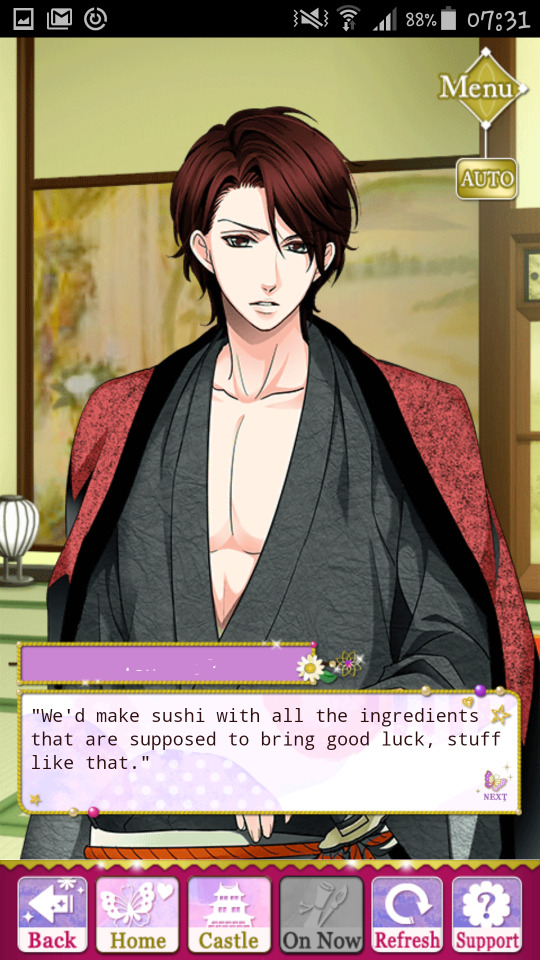

Sushi rolls don’t actually exist in the Sengoku. It’s a much much later invention. The seaweed “paper” doesn’t even exist until the 1700s, so this is all fluff anyway. In the Sengoku period, “sushi” refers to what is typically known as funazushi, that is a preserved fish fermented using rice. When the fish is fermented/preserved to a satisfactory degree, the rice will just be thrown out and not eaten.
This sushi tradition for setsubun is actually also kind of suspect, because it only became widespread in the 1980s. While legends claim that this originated in the Edo period, I’m not sure if there’s actually documented proof of this. I’ve seen some articles suspect this as just a promotional gimmick from food stores who are wanting to use up leftover ingredients, and created a nonsense legend surrounding it.
The ehoumaki 恵方巻き sushi “traditionally” contains 7 ingredients to represent the 7 lucky gods, and that eating this will bring food luck. Ingredients may vary, but the most common ones include datemaki omelettes, cucumbers, shiitake mushrooms, grilled eel, dried tofu, kanpyo gourd, and pink fish floss. These ingredients are food items that are often used in New Year meals, so I can see why this so-called tradition is rather dubious.
Unlike regular sushi that are normally sliced, ehoumaki sushi is left in the long “log” form and eaten as-is. This is said to symbolise “not breaking bonds”, and eating it like this is meant to bring good fortune. Some explanations also say that the name “ehou” means “lucky direction”. Supposedly, people in the Edo era eats the sushi while facing this “lucky direction”.
In the modern day, people sometimes just have fun with the sushi and create fun shapes and fillings. A rather new trend is making a tiger-patterned wrap with omelette and seaweed for the roll, or making cute little oni shapes with the filling:

17 notes
·
View notes
Text
New Year 2023 Manager Phone Messages
One New Year’s themed message from an idol was sent per day for 16 days from 2023/1/1.
1/1 - Riku
Manager! Happy New Year. Here’s to another year!

The chirashizushi you made was delicious! The rabbit-shaped kamaboko was also really cute!
1/2 - Mitsuki
In my first dream of the new year, I became the MC of a new program! I gotta work hard to make this dream come true! (1)
1/3 - Yuki
I'm watching the Ekiden with Momo, it's amazing (2)
I think I couldn't run that far even if I spent my whole life
1/4 - Tamaki
Manager, did you eat datemaki?
It’s my fave osechi dishi (3)

1/5 - Haruka
I heard you're good at hanetsuki (4)
The 4 of us were talking about trying it, so if you got any tips I'd like to know....
1/6 - Tenn
Thank you for the New Year's card. Did you take this picture of the rabbit? Its hopping is cute.
1/7 - Iori
I heard you took a photo of Kinako for our New Year's card, but since it'll be a topic of conversation, please send me the file.
1/8 - Momo
When it comes to New Years, it's gotta be NEXT Re:vale's special program! It's a spectacular that'll make you laugh or cry, so tune in if you can Maneko-chan!

1/9 - Minami
Have you drawn your fortune slip yet? If you'd like, I can introduce you to places you can draw a good fortune. (5)
1/10 - Sogo
I drew an eye on the matching daruma we all bought together, I think I was able to draw it rather gallantly. (6)
1/11 - Toma
The 4 of us ate kagami mochi, it tastes really good when fried! I recommend adding shichimi soy sauce! (7)
1/12 - Gaku
Thanks for coming to give us New Year's greetings. I know you're busy, but let's both have a good year!
1/13 - Yamato
When I visited my old man he made me take all this meat
I going to have sukiyaki now, so do you want to come over, Manager?
1/14 - Torao
Did you go to that hatsuuri thing? (8)
It's like a battle right? But I'm sure they sell something that's worth the trouble.
1/15 - Ryunosuke
The 3 of us played karuta and it was soo exciting! (9)
I want to play with the guys from IDOLiSH7 next time!
1/16 - Nagi
Maple butter on mochi, this may be the discovery of the century :-D

* * *
(1) Hatsuyume is the first dream of the new year, the contents of which foretell the year’s luck.
(2) New Year Ekiden is a popular marathon that happens around the New Year and is broadcast on TV.
(3) Datemaki is a sweet rolled omelette with fish. It's an osechi dish, traditional Japanese new year foods.
(4) Hanetsuki is a Japanese game similar to badminton that is often played around New Years.
(5) Omikuji are fortune slips with fortunes that range from lucky to unlucky. They can be drawn at shrines and temples, which are often visited during the new year in Japan.
(6) Daruma is a Japanese doll that is sold with blank eyes. People draw in one eye while thinking of their wish, and fill in the other eye when it's completed.
(7) Kagami mochi is a Japanese New Year's decoration that is traditionally broken apart and eaten on Januray 11th.
(8) Karuta is a card game where you try to match verses from traditional Japanese poems before your opponent.
(9) Hatsuuri when shops have the first sale of the year. Fukuburuko, lucky bags, are often sold during this.
* * *
Sticker credit
19 notes
·
View notes
Text
Happy New Year!

(Pictured above: my homemade osechi ryouri New Year’s meal for 2023! Left box contains kurikinton, kuromame, namasu, kamaboko, shrimp, datemaki, kobumaki. Right box contains nishime.)
Hope 2023 is treating you all well so far! ♥️ I got some unexpected but exciting commissions irl that are taking up a lot of my free time, but here’s how progress (??) is going on fics so far!
Wrote about 7k words of Strange Bedfellows chapter 4…and then edited out about 2k of that, because I realized it was messing with the pacing of the martial arts portion. (Gotta have those wacky martial arts, right???) About half of the scenes I took out will probably be re-edited and shuffled back in later, where they won’t slow down the action.
Reworked some of Here Comes the Bribe’s outline to make the climactic battle slightly more…climactic. 😅
Writing is such a process! It always takes me four times as long to do because I nitpick as I go, and/or spend 38 minutes to write one (1) sentence. I don’t talk about this much, but it’s also a constant uphill battle against my own brain. I’m diagnosed with (and being treated for) ADHD, but even with medication and counseling, it’s sometimes hard for me to get things done in a timely manner, especially the things outside the scope of my day-to-day work. BUT I don’t say this as an excuse, or because I want to be pitied or anything like that. I say it because I’m going to keep chugging through at my own pace despite the hurdles both internal and external, and I hope that it also encourages you to take things one day at a time, do the best you can given your own circumstances, and be patient and forgiving to yourself as you work towards your goals in 2023! Take a moment to appreciate yourself if you’ve read this far, okay?!
8 notes
·
View notes
Text
Du lịch Nhật Bản tết 2024
Du lịch Nhật Bản vào dịp Tết 2024 là một hành trình kỳ diệu mang lại cho du khách trải nghiệm đẳng cấp văn hóa và tâm linh. Nhật Bản, đất nước của sự kỳ diệu và sự kết hợp hài hòa giữa truyền thống và hiện đại, sẽ chào đón du khách bằng những lễ hội, nghi lễ đặc biệt và ẩm thực tuyệt vời trong dịp này.
Khám phá Văn Hóa Tết Nhật Bản:
Dịp Tết là thời điểm quan trọng nhất trong năm tại Nhật Bản. Khắp các thành phố và làng quê sẽ trang trí bằng những bóng đèn lồng và cờ phướn, tạo nên một không khí đầy phấn khích và rực rỡ. Du khách có thể tham gia vào các hoạt động truyền thống như viếng chùa, nơi mọi người cầu chúc may mắn và sức khỏe cho năm mới. Lễ hội Omisoka, hay đêm giao thừa, là thời điểm quan trọng nhất trong dịp Tết, khi mọi người tụ tập bên gia đình và người thân, cùng chờ đợi tiếng chuông chào đón năm mới.
Thưởng thức Ẩm Thực Tết:
Tết Nhật Bản không chỉ là một dịp để hội tụ mà còn là lễ hội của ẩm thực đặc trưng. Mỗi món ăn trong bữa tiệc Tết đều mang ý nghĩa tượng trưng, thể hiện mong muốn cho một năm mới an lành và thịnh vượng. Bữa ăn Tết, hay còn gọi là osechi ryori, thường bao gồm nhiều món như kamaboko (bánh cá), datemaki (bánh trứng cuộn), và kuromame (đậu đen đường). Không thể không nhắc đến mochi, loại bánh dẻo truyền thống được ưa chuộng trong dịp này. Ngoài ra, du khách cũng không thể bỏ qua cơ hội thưởng thức sushi và sashimi tươi ngon tại các nhà hàng địa phương.
Trải nghiệm Lễ Hội và Nghi Lễ Đặc Biệt:

Trong suốt thời gian Tết, các lễ hội truyền thống diễn ra khắp nơi ở Nhật Bản. Tại Kyoto, du khách có thể tham dự lễ hội Hatsumode tại các đền chùa lịch sử như Fushimi Inari và Kiyomizu-dera. Tại Osaka, lễ hội Sumiyoshi Taisha là một sự kiện lớn được tổ chức để tôn vinh các vị thần bảo vệ. Các di tích lịch sử và văn hóa khác như Himeji Castle, Hiroshima Peace Memorial Park cũng thu hút đông đảo du khách trong dịp này.
Mua sắm và Lễ Hội Đường Phố:
Ngoài việc tham gia vào các hoạt động truyền thống, du khách cũng có thể tận hưởng không khí sôi động tại các khu vực mua sắm và lễ hội đường phố. Tại Tokyo, khu phố Shibuya và Shinjuku sẽ trở nên sôi động với những đèn lồng và màn biểu diễn nghệ thuật đường phố. Các cửa hàng và quán cafe cũng thường mở cửa đến khuya để phục vụ nhu cầu mua sắm và giải trí của du khách.
youtube
Kết Luận:
Du lịch Nhật Bản vào dịp Tết 2024 không chỉ là một chuyến hành trình mà còn là một trải nghiệm tâm linh và văn hóa đầy ý nghĩa. Từ những lễ hội truyền thống đến ẩm thực đặc trưng và không khí sôi động của các khu phố, du khách sẽ có cơ hội khám phá và thấu hiểu sâu hơn về đất nước và con người Nhật Bản trong dịp đặc biệt này.
0 notes
Text
Traditional New Year foods from various parts of the world
The specific foods associated with New Year celebrations vary widely across different cultures and traditions. Here are some examples of traditional New Year foods from various parts of the world:
Lentils (Italy): In Italy, lentils are eaten during the New Year as they are believed to bring good luck and prosperity. Their round shape resembles coins, symbolizing wealth.
Grapes (Spain and Latin America): In Spain and many Latin American countries, it is a tradition to eat 12 grapes at the stroke of midnight on New Year's Eve—one for each chime of the clock. It is believed to bring good luck for each month of the upcoming year.
Osechi Ryori (Japan): In Japan, Osechi Ryori is a traditional New Year's meal consisting of various dishes with symbolic meanings. Examples include kuromame (sweet black beans for health), datemaki (sweet rolled omelet for joy), and kazunoko (herring roe for fertility).
Soba Noodles (Japan): Another Japanese tradition involves eating toshikoshi soba, a type of noodle dish, on New Year's Eve. The long noodles symbolize longevity and are meant to be eaten to cross over from one year to the next.
Hoppin' John (Southern United States): Hoppin' John is a dish made with black-eyed peas, rice, and pork, often eaten in the Southern United States on New Year's Day. It is thought to bring good luck and prosperity.
Pork and Sauerkraut (Germany): In Germany, pork and sauerkraut are traditional New Year's foods. Pork symbolizes progress, and sauerkraut is thought to bring blessings and wealth.
Pomegranate (Greece): In Greece, it is customary to smash a pomegranate on the floor at midnight on New Year's Eve. The number of seeds that scatter represents the prosperity and good fortune that the new year will bring.
Fish (Many Cultures): Fish is a common New Year's dish in many cultures. In some places, fish is associated with abundance and fertility. In China, serving a whole fish symbolizes a good beginning and end to the year.
Cake and Pastries (Various): Many cultures celebrate with sweet treats on New Year's Eve or New Year's Day. In some places, a special New Year's cake or pastries may be prepared to symbolize sweetness and good fortune.
Tteokguk (Korea): Tteokguk, a traditional Korean soup made with sliced rice cakes, is often eaten on New Year's Day. It symbolizes gaining a year in age and is associated with the wish for a long, healthy life.
These are just a few examples, and traditions can vary widely. The choice of New Year foods often carries symbolic meaning, reflecting cultural beliefs and superstitions related to luck, prosperity, and well-being.
0 notes
Text
Yeah buddy!! イェ〜バディ!!

さあ来ましたよ。海外からのお客様。えんでかしはインバウンドも対応可ですからね。英語はソーソーですが。ソーソーなりにやってます。
Here they come. Customers from overseas. Endekashi can also handle inbound visitors. My English is so-so. I'm doing my best in my own way.

本日のお客様 from Canada。プライベートでお申し込みいただきました。あれ?後ろにおわしますは、当ブログでお馴染みの塾長じゃございませんか?
Today's guest from Canada, who applied for private. Oh, Isn't that the well-known Zyukutyo(his nickname) of this blog behind him?

なんと!今日は色々が色々でして塾長はテールガイドとして来ていただいております!大人の事情もございますのであまり深く詮索しないで下さいな。(かなりしょうもない理由なんですが。)塾長についてご存知ない読者様に紹介いたしますと、彼はスプリットボードの、とりわけスキーモードを得意とする方で自ら小野塾と銘打ち、日本全国津々浦々、顎足枕のみでスプリットボードの技術向上の為に各地で講習を開いている稀有な存在です。更に特筆すべきはそのユニークな行動食の数々。果たして今シーズンはどんな行動食が出てくるのでしょう。まずは挨拶代わりに干し柿が出て参りました。
What a surprise! Today, due to a variety of reasons, the Zyukutyo is here as a tail guide! Please don't pry too deeply into it, as there are adult circumstances. (It's a rather silly reason…) For those of you who don't know about him, he is a rare person who specializes in splitboarding, especially in ski mode, and has been teaching courses all over Japan to improve splitboarding techniques using only a chin-feet pillow.(means Food, Transportation, Lodging) What is even more remarkable is his unique diet. What kind of food will be served this season? First of all, dried persimmons were served as a greeting.

しかし、本日のお客様もなかなかな手練れです。なんとスプリットボードにハードブーツのセッティング!ハードブーツのメリットを聞くと、横にブレずに直進方向での推進力が増すそうです。なんでも彼がよく滑りに行くレベルストーク周辺では山へ取り付く前に結構な平らを移動しなければならないらしく、このセッティングだとガシガシ前に進むそうで調子いいそうです。
However, today's customer is also quite skilled. He is using a splitboard with hard boots! He told us that the hard boots give him more propulsion in a straight line direction without shaking sideways. He said that he has to move flat field around Revelstoke, where he often goes to ski, before reaching the mountain, and with this setting, he can go straight and forward without shaking.

ポールもなかなかオリジナル。カナダ内陸特有の寒さに対応する凍り付かない広めなグリップ。そして深雪でも沈まないサイズのデカいバスケット。なんでも現地のガイドが開発しているようで興味のある人はちょっと見てみてください。Wolverine Snow Productsといいます。
The poles are also quite original. Wide grips that don't freeze up in the cold, which is typical of Canada's interior. And the basket is big enough not to sink even in deep snow. developed by local guides, so if you are interested, take a look. It is called Wolverine Snow Products.

という訳でこのセッティングで足も長いからかなりのハイペース!久々のハイペースにシーズン初めのえんでかしはタジタジ。
So with this setting and long legs, the pace was quite fast! It's been a while since I've been able to keep up a high pace, so I was a bit nervous because my body wasn't quite ready yet.

しかし遥々カナダからお越しいただいた大事なお客様。満足させらるように粉骨砕身、精一杯おもてなしさせていただきやす!!
However, they are important guests who have come all the way from Canada. We will do our best to satisfy them!
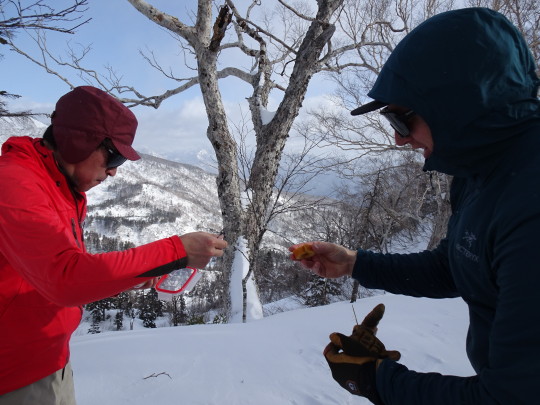
毎度お馴染み、塾長のお正月の伊達巻。日本の食文化を伝えております。
Every time we are familiar with the Zyukutyou's New Year's Datemaki. He is conveying Japanese food culture.

天気悪そうな予報だったので最初は近場でチャプチャプしようかと思っていましたが、思ったより天候も悪くなく、なんならあっち行けそうじゃね?
The weather forecast looked bad, so at first I thought we would go short lines in the vicinity, but the weather was not as bad as I thought, and we could go that way if we wanted to, right?

ちゅー訳でハイペースでひとっ飛びー!
So, We took off at a high pace!

なかなか美味そうですぞ!
It looks quite tasty!

まずは塾長が味見。
First, Zyukutyo tastes it.

東面は昨日の日射でクラストを感じますが北面にはドライないいほうていがありました!
The east face felt crusty from yesterday's sunshine, but there was good dry snow on the north face!

続いてどうぞ!!
Please continue!

日本のパウダーを堪能していただいてるようです。
He seem to be enjoying the Japanese powder.

トップ トゥ ボトムのロングラン!気持ちいい〜!!
Top to bottom long run! Feels good~!

ちょっと一休みしましょうか。おや?徐に取り出したのはゆで卵!これには塾長もわかってるね〜と感心な眼差し。
Let's take a break. Oh? What he took out slowly was a boiled egg! Zyukutyo looked at him with admiration and said, "You know what you're doing.

それを立て続けに3つ平らげてました!根本的な違いを感じますね〜。
He was eating three of those in a row! feel a fundamental difference!

塾長はなんすか?あ!でた!お汁粉!!無茶美味そう!!
What's the Zyukutyo? Ah! It was! Oshiruko!( Looks absurdly delicious!
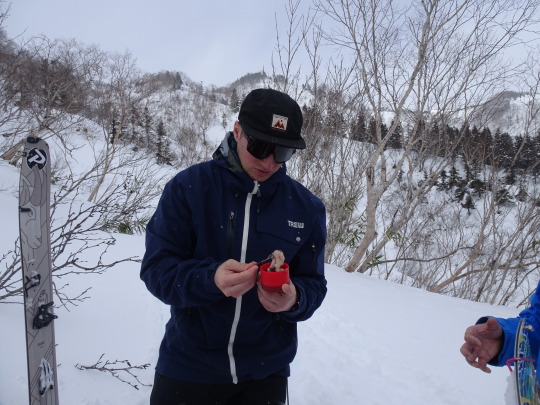
日本の食文化を伝えていました。
He was conveying Japanese food culture.

さーて登り返して、帰るにはまだ早い時間。もう一本行っちゃう?
モチのロン!!
Well, it's still early to go home. Shall we go for one more?
Of course!

相変わらずのハイペースでサクッと到着!
Arriving quickly and at the same high pace as ever!

良さそうには見えるが果たして!?
It looks good, but is it?

東面なので昨日の日射の影響もありましたが北面はいい雪!!
It was on the east face, so there were some effects of yesterday's solar radiation, but on the north face, good snow!

美味い!!
Delicious!

いや〜満腹満腹!
Well - full stomach, full stomach!

帰りの林も昨日の日射の割には悪くなっかったです。
The tree lines on the way back were not too bad for yesterday's solar radiation.

てな訳で無事にゲレンデに帰って参りました。
あれ?二人とも何してんの?
え?スキーモードでゲレンデ滑る!?
ドヒャー!!
And so We returned safely to the slopes.
Huh? What are you two doing?
Huh? Skiing the slopes in ski mode!?
Wow!!

二人共無茶うまー!
塾長曰く北米では全然普通だそうです。
世界は広い。
Both of them are recklessly good!
According to the Zyukutyo, it is totally normal in North America.
The world is a big place.

という訳で無事到着!!
楽しみましたね!
彼はまた明後日来てもらう予定です!降雪後、楽しみですね!!
本日もお疲れ山&おしょっ様でしたー!!
So we arrived safely!
We had fun, didn't we?
He will be back the day after tomorrow! After the snowfall, we are looking forward to it!
Thanks again for your hard work today!
0 notes